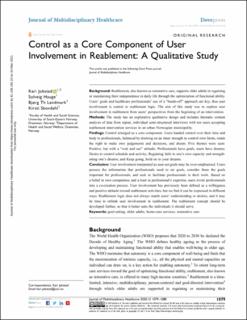| dc.contributor.author | Jokstad, Kari | |
| dc.contributor.author | Hauge, Solveig | |
| dc.contributor.author | Landmark, Bjørg Th. | |
| dc.contributor.author | Skovdahl, Kirsti | |
| dc.date.accessioned | 2021-03-24T12:20:58Z | |
| dc.date.available | 2021-03-24T12:20:58Z | |
| dc.date.created | 2020-12-14T22:03:52Z | |
| dc.date.issued | 2020 | |
| dc.identifier.citation | Jokstad, K., Hauge, S., Landmark, B. T., & Skovdahl, K. (2020). Control as a Core Component of User Involvement in Reablement: A Qualitative Study. Journal of Multidisciplinary Healthcare, 13. | en_US |
| dc.identifier.issn | 1178-2390 | |
| dc.identifier.uri | https://hdl.handle.net/11250/2735297 | |
| dc.description.abstract | Background: Reablement, also known as restorative care, supports older adults in regaining or maintaining their independence in daily life through the optimization of functional ability. Users’ goals and healthcare professionals’ use of a “hands-off” approach are key, thus user involvement is central to reablement logic. The aim of this study was to explore user involvement in reablement from users’ perspectives from the beginning of an intervention. Methods: The study has an explorative qualitative design and includes thematic content analysis of data from repeat, individual semi-structured interviews with ten users accepting reablement intervention services in an urban Norwegian municipality. Findings: Control emerged as a core component. Users handed control over their time and body to professionals, balanced by drawing on an inner strength to control own limits, retain the right to make own judgements and decisions, and dream. Five themes were seen: Positive, but with a “wait and see” attitude; Professionals have goals, users have dreams; Desire to control schedule and activity; Regaining faith in one’s own capacity and strengthening one’s dreams; and Keep going, hold on to your dreams. Conclusion: User involvement interpreted as user-set goals may be over-emphasized. Users possess the information that professionals need to set goals, consider these the goals important for professionals, and seek to facilitate professionals in their work. Based on a belief in own competence and a trust in professional’s expertise, users invite professionals into a co-creation process. User involvement has previously been defined as a willingness and positive attitude toward reablement activities, but we find it can be expressed in different ways. Reablement logic does not always match users’ understanding or desires, and it may be time to rethink user involvement in reablement. The reablement concept should be developed further, so that it better suits the individuals it should serve. | en_US |
| dc.language.iso | eng | en_US |
| dc.rights | Navngivelse-Ikkekommersiell 4.0 Internasjonal | * |
| dc.rights.uri | http://creativecommons.org/licenses/by-nc/4.0/deed.no | * |
| dc.title | Control as a core component of user involvement in reablement: A qualitative study | en_US |
| dc.type | Journal article | en_US |
| dc.type | Peer reviewed | en_US |
| dc.description.version | publishedVersion | en_US |
| dc.rights.holder | © 2020 Jokstad et al. | en_US |
| dc.source.pagenumber | 1079-1088 | en_US |
| dc.source.volume | 13 | en_US |
| dc.source.journal | Journal of Multidisciplinary Healthcare | en_US |
| dc.identifier.doi | https://doi.org/10.2147/JMDH.S269200 | |
| dc.identifier.cristin | 1859771 | |
| dc.relation.project | Norges forskningsråd: 259637 | en_US |
| cristin.ispublished | true | |
| cristin.fulltext | original | |
| cristin.qualitycode | 1 | |

